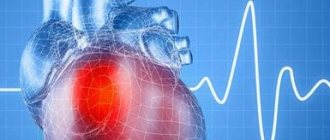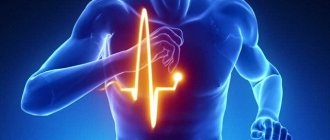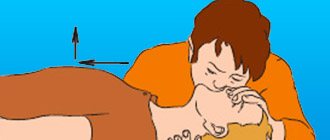Heart disease in children: what is important to know
How often do children experience cardiovascular diseases?
Often. This is mainly due to congenital pathologies - heart defects, abnormalities of the cardiac conduction system, rhythm disturbances. In such cases, to correct heart failure, the child is prescribed drug therapy or surgery with further observation by a cardiologist.
Fig 1. Myocarditis
What pathologies are common?
In first place are congenital heart defects, in second place are myocarditis and cardiomyopathies. Next is a violation of the rhythm and conductivity of the heart, which, by the way, is the cause of sudden deaths in children while playing on playgrounds or doing physical education. There are also children with arterial hypertension. In this case, from an early age they are forced to receive antihypertensive drugs in order to stabilize blood pressure. Kawasaki disease also occurs, in which vascular damage occurs. Of course, if you go deeper, there are many more diseases, and there are also rare pathologies.
At what age are congenital heart defects and developmental anomalies usually detected in a child? And how is the treatment going?
Typically, such conditions are diagnosed when the baby is born. Although now, taking into account the development of modern diagnostic methods, including ultrasound, these defects are more often diagnosed in utero. Unfortunately, defects can be critical, that is, they are not compatible with life, and then doctors recommend termination of pregnancy at any stage.
Children with non-critical heart defects may require both surgery and medication, depending on the case.
In addition to congenital, are there also acquired heart diseases?
Yes. These include, first of all, myocarditis and cardiomyopathies. Myocarditis is an inflammation of the heart muscle, which most often occurs after an infection. At the same time, myocarditis can be caused not only by respiratory infections, but also by enteroviruses (most often the Coxsackie virus), as well as adenovirus. This disease is dangerous because it can develop completely suddenly
. For example, a child has suffered from some kind of infectious disease, and after two weeks he becomes ill, shortness of breath, rapid heartbeat, pain in the chest, and fatigue increases. Myocarditis is treated only in a hospital, otherwise severe complications are possible. Cardiomyopathy (changes in the heart muscle) can occur after myocarditis (so-called dilated cardiomyopathy), or can develop due to improper synthesis of heart muscle proteins or their excessive accumulation as a result of a genetic failure. In this case, all close relatives of the sick child are sent for a special genetic examination to establish the hereditary nature of the disease.
For cardiomyopathy, both inpatient and outpatient treatment are possible - it all depends on the severity of the disease.
Often during a clinical examination, the doctor notes a heart murmur in the child. How dangerous is this condition?
Noises can be pathological and physiological (functional). Pathological noises are caused by either a defect or dysfunction of the myocardium (with myocarditis). This can be determined through an examination to which the child will be referred by a doctor. And if the diagnosis is confirmed, the patient will be prescribed appropriate treatment.
And physiological murmurs are sound phenomena that occur when the valves and chambers of the heart are intact, that is, healthy. Most often, physiological noises change depending on the position of the body: when the child is lying down, they can be heard well, and when he is standing, they are heard worse. This is a very good sign prognostically. That is, if I observe such a picture, then I am 90% sure that this is just functional noise, and it does not pose a threat to the life and health of the child. However, even in this case, the correct action on the part of the pediatrician is to send the child for a heart ultrasound to rule out pathological conditions.
Is it possible to suspect that a child has heart problems in order to prevent a tragedy?
Clinically, these conditions do not manifest themselves in any way - the child has practically no complaints. However, there is one indicator on the ECG that can indicate pathological changes - the QT interval. If it is longer than normal (long QT syndrome), it means that ion exchange processes in the heart are disrupted, which leads to sudden tachycardia and subsequent cardiac arrest.
It is important to have regular check-ups with a cardiologist, and doctors need to pay attention to the QT interval. If pathology is detected in time, tragedy can be avoided.
What should you do if your child loses consciousness while playing or playing sports?
First of all, you need to call an ambulance. Then make sure that the child is not in danger, check for the presence/absence of breathing, and palpate the pulse. If the pulse cannot be felt, then while waiting for doctors, it is important to perform cardiopulmonary resuscitation, which consists of compressions on the chest and ventilation of the respiratory tract through the mouth.
How to keep your child healthy and minimize the risk of developing cardiovascular diseases?
Be sure to undergo medical examination at the prescribed time. It is also important to pay attention to fainting and pre-fainting conditions, and if you experience fainting, contact not only a neurologist, but also a cardiologist.
If a child complains of lack of stamina, fatigue, decreased activity, lethargy, sweating, or if he can no longer cope with his usual load, he should immediately consult a doctor.
If the child is healthy and examined, then it is important to lead a healthy lifestyle and exercise regularly. This is beneficial for both the cardiovascular system and resistance to infectious diseases.
Congenital heart disease in newborns - what is it?
The disease congenital heart disease implies an anatomical pathology or defect (impairment) in the development of the heart and/or large vessels, as well as the valve apparatus, which leads to cardiac overload, myocardial insufficiency of the heart chambers and changes in blood flow.
Congenital heart defects in children are called when pathologies formed before the birth of the child, during the intrauterine period of fetal development.
Most often, congenital heart defects in future newborns develop between the second and eighth weeks of pregnancy.
A disease such as congenital heart disease is relatively rare. Out of every thousand babies born, six to eight children are given a similar diagnosis.
Possible complications of congenital heart disease in newborns
Sometimes there are cases when, when diagnosed with congenital heart disease, a newborn does not show any signs of the disease.
The absence of symptoms may continue until primary school age. At this age, any congenital heart defect in children manifests itself. The child begins to lag behind his peers in physical development, suffocates during exercise, and his skin turns pale or blue. Not only poor physical performance, but also learning problems, emotional disorders - all this can be caused by one disease.
Unfortunately, a child with congenital heart disease subsequently needs lifelong monitoring of his health due to the possible development of complications and concomitant diseases. Even if surgery was performed at an early age, it is not a panacea for life. In addition, strict dosing of physical activity will be necessary throughout your life.
Congenital heart defects in children can be complicated by other diseases.
Among them:
- Heart failure
- Early prolonged pneumonia
- High pulmonary hypertension
- Endocarditis
- Syncope (loss of consciousness)
- Angina pectoris
- Myocardial infarction
- Attacks of shortness of breath and blueness
Causes of congenital heart disease in newborns
Scientists still cannot name the exact causes of congenital heart disease.
However, the good news is that most of them can be corrected surgically. Surgery on a congenital heart defect gives the child the opportunity for normal development and growth.
Thanks to a series of studies, scientists were able to identify a number of factors that increase the risk of congenital heart disease in newborns:
- Viral (if the child was conceived or carried for the first three months of pregnancy during a viral epidemic; influenza and rubella viruses are especially dangerous).
- Ecological (parents living in environmentally disadvantaged areas).
- Exposure of the fetus to ionizing radiation.
- Genetic (hereditary predisposition).
- Bad habits of parents (alcoholism and drug addiction of mothers are especially terrible).
- Autoimmune or severe chronic diseases in parents (the most common negative effect is systemic lupus erythematosus or diabetes in the expectant mother).
- Taking certain medications during pregnancy (containing ethanol, thalidomide, amphetamines, anticonvulsants, trimethadione, lithium, progestogens).
- The mother's age is over 35-37 years.
Symptoms of congenital heart defects in newborns
The clinical picture of the manifestations of the disease depends on the type of congenital heart defect in newborns, the types of hemodynamic and circulatory disorders.
Most often, immediately after the birth of a child (or soon after that - in the first days, weeks, months of life) “blue” defects begin to appear, which are impossible without the manifestation of the main symptom - cyanosis (blue skin). However, “white” defects may also have similar symptoms. Both are serious congenital heart defects in newborns that must be treated (including congenital heart surgery) to avoid further complications or even death.
Symptoms of congenital heart disease in a newborn that should not be ignored:
- A bluish or bluish tint to the skin, lips, and ears (cyanosis), which can appear both at rest and during feeding and crying.
- On the contrary, pallor, unhealthy white skin color, and cold extremities are possible.
- Dyspnea.
- Swelling (around the eyes, stomach and legs).
- Low weight gain (caused by the baby's shortness of breath, which does not allow him to eat properly during breastfeeding).
- Tachycardia (rapid heartbeat).
- Heart murmurs (this symptom can only be detected by doctors when listening to the child’s heart).










